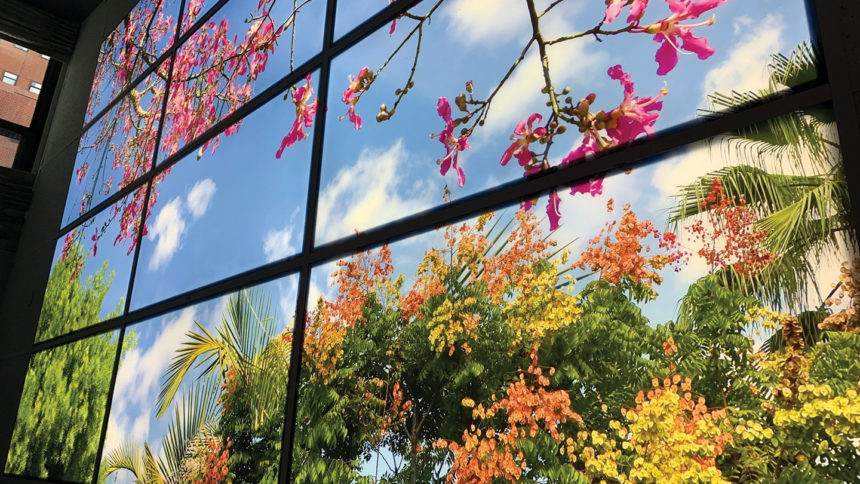Paintings and interior design materials inside the Mary Immaculate Health/Care Services’ memory care unit are meant to engage residents in people-watching and interaction. They include murals and features that bring the outdoors in.
Bruce Springsteen once asked, “Does this bus stop at 82nd Street?” The song was about New York, but it also applies to Lawrence, MA, home to the Mary Immaculate Health/Care Services and its innovative new memory care unit.
The Bus Stop has become a popular meeting place for cognitively challenged residents, and even though the bus never comes, the stop has an important purpose, says Rebecca Alfonso, program director for memory care.
“It’s a popular people-watching spot, like a porch,” she says. “It also serves as a place for reminiscing, like, ‘What bus number did you take to work?’ After a while, it becomes a natural way to say, ‘Let’s go get a drink while we wait.’”
The “bus stop” is one component of a design theme that follows the Alzheimer’s Association Habilitation Therapy Program, which creates a world patterned after residents’ earlier lives. The $500,000 project features similar elements such as a meeting tree, post office, memory garden and quiet room.
The 41-unit memory care center is part of a comprehensive eldercare campus.The project took about two years to complete, MIHCS CEO Jeanne Leydon says.
“We did a lot of the work ourselves,” she says. “We had volunteers to paint, build closets and shelving.”
Leydon credits retired Maintenance Director John Raymond with creative vision on elements such as the “back porch.” Residents can sit on a couch or in glider chairs to view a landscape mural beyond a handmade porch railing.
Aesthetic and functional details are paramount in the décor, designed to enable “wayfinding” for residents, whereas furnishing materials promote safety. Three neighborhood styles are based on resident demographics and area history — stucco represents the Latinx population, clapboard represents the working class and brick is reminiscent of the town’s factory past.
Each neighborhood is designed in a specific color that assists residents in navigating their way back “home.” Light fixtures, color-coded doors and mail slots are part of each resident’s entrance, for instant recognition. Flooring is tactile, skid-resistant and has a cushioned underlayer to prevent injuries.
As a dementia specialist, Alfonso carefully researched the environmental aspects of the design to create “a positive and relaxed” atmosphere. Working with a design committee, she and the group determined which materials offered the most resident protection.
The center’s holistic approach is a radical departure from conventional methods, Leydon says.
Lessons learned
- The Alzheimer’s Association Habilitation Therapy Program is a progressive method for creating a safe and comforting environment for cognitively challenged residents.
- Using volunteers for tasks such as painting and carpentry is an effective way to save money.
- Safe materials such as tactile, cushioned flooring are worth the extra expense, to ensure resident safety.


